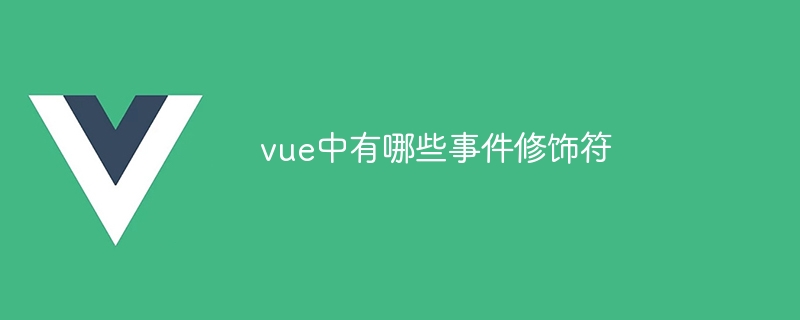What are the event modifiers in vue
Vue event modifiers: 1. stop: Prevent events from bubbling. 2. prevent: Prevent the default event behavior. 3. capture: Capture events in the capture phase. 4. self: Triggered only when the event occurs on the element itself. 5. once: The event is triggered only once, and then the listener is removed. 6. Passive: Does not prevent page scrolling or UI interaction. 7. lazy: Delay the creation of the listener until the element is added to the DOM. 8. debounce: trigger an event only once within a specified time (for example, @click.debounce.500). 9. throttle: trigger an event only once within a specified time interval (for example, @c

##Vue event modifier
stop
- Prevent events from bubbling, that is, prevent events from propagating upwards
- Format:
- @click.stop
prevent
##Prevent default event behavior, such as form submission or link jump.- Format: @click.prevent#.
Capture events in the capture phase, not in the bubbling phase. The capture phase means that the event propagates upward from the target element. Stage triggered when the document root element is reached
- Format:
- @click.capture
-
##self
##Only triggered when the event occurs on the element itself, not on its child elements Format:
@click.self- # #once
Format: @click.once
- passive
Format: @scroll.passive
- ##lazy
-
Delay event listener creation until the relevant element is added to the DOM
@click.lazy
- debounce
-
The event will only be triggered once within the specified time, even if there are many events in a short period of time
@click.debounce.500, where 500 is the number of milliseconds. ##The event is triggered only once within the specified time interval, even if the event is triggered multiple times within this time interval.
- Format:
- @click.throttle.500 , where 500 is. Number of milliseconds.
The above is the detailed content of What are the event modifiers in vue. For more information, please follow other related articles on the PHP Chinese website!

Hot AI Tools

Undresser.AI Undress
AI-powered app for creating realistic nude photos

AI Clothes Remover
Online AI tool for removing clothes from photos.

Undress AI Tool
Undress images for free

Clothoff.io
AI clothes remover

Video Face Swap
Swap faces in any video effortlessly with our completely free AI face swap tool!

Hot Article

Hot Tools

Notepad++7.3.1
Easy-to-use and free code editor

SublimeText3 Chinese version
Chinese version, very easy to use

Zend Studio 13.0.1
Powerful PHP integrated development environment

Dreamweaver CS6
Visual web development tools

SublimeText3 Mac version
God-level code editing software (SublimeText3)

Hot Topics
 How to use bootstrap in vue
Apr 07, 2025 pm 11:33 PM
How to use bootstrap in vue
Apr 07, 2025 pm 11:33 PM
Using Bootstrap in Vue.js is divided into five steps: Install Bootstrap. Import Bootstrap in main.js. Use the Bootstrap component directly in the template. Optional: Custom style. Optional: Use plug-ins.
 How to add functions to buttons for vue
Apr 08, 2025 am 08:51 AM
How to add functions to buttons for vue
Apr 08, 2025 am 08:51 AM
You can add a function to the Vue button by binding the button in the HTML template to a method. Define the method and write function logic in the Vue instance.
 How to use watch in vue
Apr 07, 2025 pm 11:36 PM
How to use watch in vue
Apr 07, 2025 pm 11:36 PM
The watch option in Vue.js allows developers to listen for changes in specific data. When the data changes, watch triggers a callback function to perform update views or other tasks. Its configuration options include immediate, which specifies whether to execute a callback immediately, and deep, which specifies whether to recursively listen to changes to objects or arrays.
 What does vue multi-page development mean?
Apr 07, 2025 pm 11:57 PM
What does vue multi-page development mean?
Apr 07, 2025 pm 11:57 PM
Vue multi-page development is a way to build applications using the Vue.js framework, where the application is divided into separate pages: Code Maintenance: Splitting the application into multiple pages can make the code easier to manage and maintain. Modularity: Each page can be used as a separate module for easy reuse and replacement. Simple routing: Navigation between pages can be managed through simple routing configuration. SEO Optimization: Each page has its own URL, which helps SEO.
 How to return to previous page by vue
Apr 07, 2025 pm 11:30 PM
How to return to previous page by vue
Apr 07, 2025 pm 11:30 PM
Vue.js has four methods to return to the previous page: $router.go(-1)$router.back() uses <router-link to="/" component window.history.back(), and the method selection depends on the scene.
 How to reference js file with vue.js
Apr 07, 2025 pm 11:27 PM
How to reference js file with vue.js
Apr 07, 2025 pm 11:27 PM
There are three ways to refer to JS files in Vue.js: directly specify the path using the <script> tag;; dynamic import using the mounted() lifecycle hook; and importing through the Vuex state management library.
 How to use vue traversal
Apr 07, 2025 pm 11:48 PM
How to use vue traversal
Apr 07, 2025 pm 11:48 PM
There are three common methods for Vue.js to traverse arrays and objects: the v-for directive is used to traverse each element and render templates; the v-bind directive can be used with v-for to dynamically set attribute values for each element; and the .map method can convert array elements into new arrays.
 How to jump to the div of vue
Apr 08, 2025 am 09:18 AM
How to jump to the div of vue
Apr 08, 2025 am 09:18 AM
There are two ways to jump div elements in Vue: use Vue Router and add router-link component. Add the @click event listener and call this.$router.push() method to jump.






